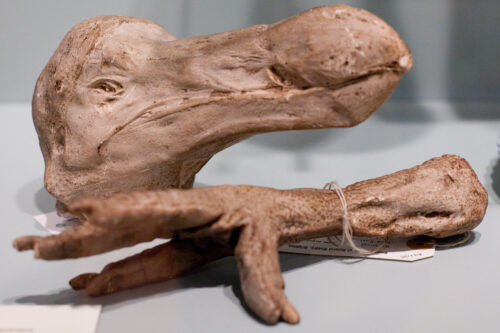Can CRISPR Bring Back Extinct Animals? From Scope, the blog of the Yale Scientific Magazine.
A, T, G, C—four molecules, infinite possibilities. These simple letters represent nucleotides that form the blueprint of life, DNA, which encodes proteins that shape cells, tissues, organs, entire beings. From the swinging agility of a monkey to the towering presence of an elephant, the identity of every species begins in its DNA.
Theoretically, altering a DNA sequence could reshape a species, allowing it to express traits from another animal. Today, biotechnology companies and researchers are attempting just that—using genetic editing to bring extinct species back to life.
The ecological benefits of bringing extinct species back are speculated to be large. A recent article in Yale Environment 360 raises concerns about the language of “de-extinction” espoused by biotech companies. Yet, companies like Colossal Biosciences say that de-extinction would bring positive changes. Mammoths could fight climate change and conserve Siberian permafrost by stepping on and packing the snow on the ground, which insulates the earth from winter’s freezing temperatures. Reintroducing the Tasmanian tiger as an apex predator could help balance the food chain in Australasian forests.
After decades of advancement in gene editing, the first company to attempt this “Jurassic World” project is Colossal Biosciences, founded in 2021 by George Church and Ben Lamm. Colossal is a biotechnology company that is attempting to use genetic editing to revive various species, including the woolly mammoth by equipping Asian elephants with mammoth traits.
Their primary tool for gene editing is clustered regularly interspaced short palindromic repeats, more commonly known as CRISPR. It uses single-stranded RNA to guide the Cas9 protein to bind to precise locations in the genome. Once bound, Cas9 acts as a molecular scalpel, using “scissor-like” proteins called restriction enzymes to cleave DNA and facilitate the insertion of desired nucleotides.
To introduce traits from extinct species, researchers extract fragmented DNA from fossils, piecing together genetic blueprints that once defined these lost organisms. This recovered genetic code serves as a guide for engineering CRISPR-Cas9 systems, allowing scientists to modify the genomes, or complete sets of genes, of closely related living species in an effort to reintroduce lost traits.
Lamm details the fundraising process that secured $225 million for Colossal to “de-extinct” the woolly mammoth. Given the company’s low likelihood of immediate returns, attracting investors was challenging. However, Lamm found that framing the effort around de-extinction and bringing back species that play important ecological roles, such as pollinators or other keystone species, generated enough buzz to draw a new class of investors traditionally uninterested in conservation.
Yet, Colossal’s work does not truly resurrect extinct species—it genetically edits existing ones to resemble them. This distinction has led ecology specialists and ethicists, like Clare Palmer, a professor of philosophy at Texas A&M University, to call for more precise terminology. Palmer warns that the term “de-extinction” can be misleading, as it suggests species are being fully restored rather than recreated in an altered form.
While Palmer supports Colossal’s work and recognizes the risk of losing public interest without the buzzword, she emphasizes a key concern. “If people believe species can truly be brought back using that term [‘de-extinction’], they may become less concerned about preventing extinctions,” Palmer said. This reflects a moral hazard problem, where the perception of reversibility could lead to riskier behaviors and reduced efforts to protect endangered species.
This concern is especially relevant to one of Colossal’s most recent projects: “reviving” the dodo. Once driven to extinction by human overhunting, the dodo has become a cultural symbol of irreversible loss, giving rise to the phrase “dead as a dodo.” Though Colossal cannot bring the dodo back exactly, if the terminology can make people think an extinct species can return, what would the word “extinction” come to mean?

